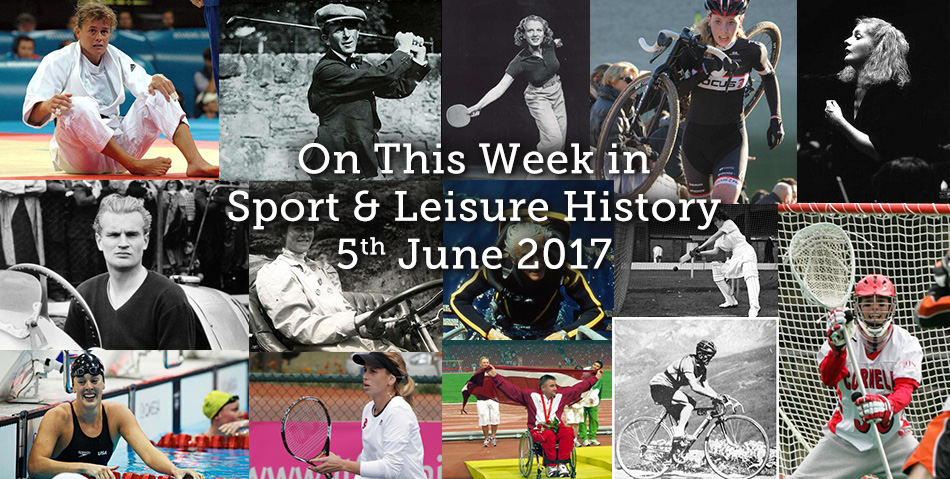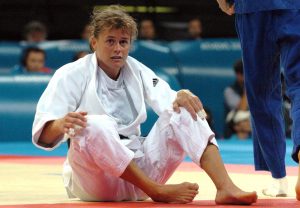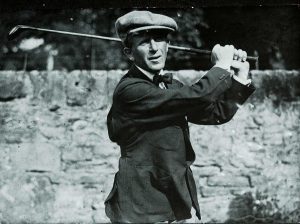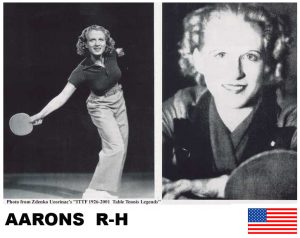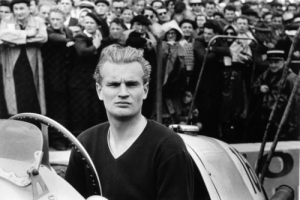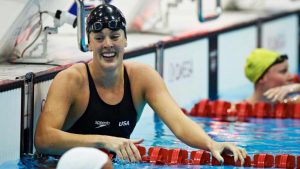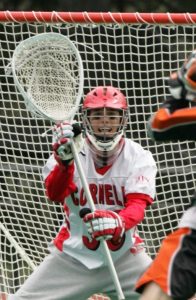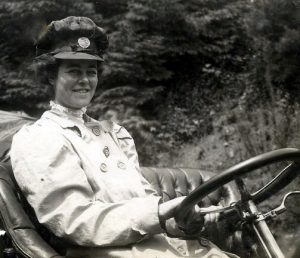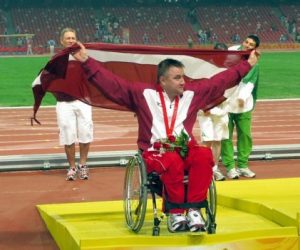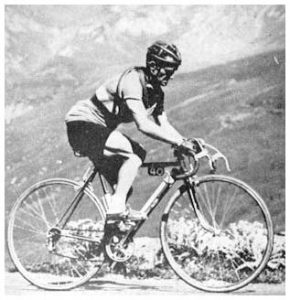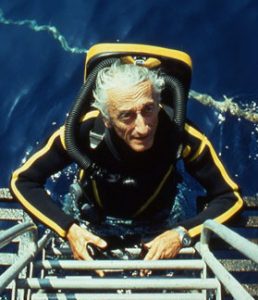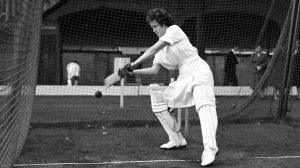5th – Frederick “Fred” Lorz, American Marathon runner was born in 1884. He won the 1905 Boston Marathon but is probably best known for his “finish” in the marathon at the 1904 Olympics. In that marathon he stopped running because of exhaustion after nine miles and his manager gave him a lift in his car for the next eleven miles, after which it broke down; Lorz then continued on foot back to the Olympic stadium, where he broke the finishing line tape and was greeted as the winner of the race. Though he initially went along with it, he soon admitted that it was a joke after spectators claimed that he had not run the entire race. Thomas Hicks went on to become the real winner, though he too had an unusual race, walking part of the route and being assisted by strychnine, which has since been banned; among the 32 runners that entered, he was one of several who came near death (along with William Garcia), and he retired the next day. Lorz was banned for life by the Amateur Athletic Union, but was reinstated soon afterwards after he apologized for the stunt and it was found that he had not intended to defraud. He won the Boston Marathon in 1905 with a time of 2:38:25. Lorz was suspended a second time by the Amateur Athletic Union for participating in an unsanctioned meet at the games of the Thomas Jefferson Club at Witzel’s Grove, Long Island, New York in August 1905. His application for reinstatement was denied; he was originally required to wait two years before applying for reinstatement, but he was reinstated in time to run the 1906 Chicago Marathon, where he finished fourth. The Estonian middleweight weightlifter Juhan “Jaan” Kikkas was born in 1892. He won a bronze medal at the 1924 Olympics, setting a world record in the snatch. Kikkas first trained as a cyclist, and changed to weightlifting in 1921, aged 29. The following year he came fourth at the world championships. In 1925 he won his only national weightlifting title. After retiring from competitions he ran his metal workshop in Tallinn. He died there in 1944 during a Soviet air raid. Eric Hollies, the English cricketer mainly remembered for taking the wicket of Donald Bradman for a duck in Bradman’s final Test match innings, was born today in 1912. Hollies played his entire first-class cricket career for Warwickshire, taking 2,323 wickets at less than 21 apiece. American children’s author and illustrator Richard Scarry was born in 1919. He published over 300 books with total sales of over 100 million worldwide. The 1938 World Cup match between Brazil and Poland at the Stade de la Mainau, Strasbourg, was remarkable for being the first in the final stages of the competition on which two players each scored four goals. Leonidas of Brazil scored his fourth goal three minutes into extra time to become the first man to score four goals I the World Cup. Fifteen minutes later Ernst Willimowski of Poland scored his fourth to become the second man to do so. The final score was 6-5 to Brazil. Also on this day in 1938, East German hurdler Karin Balzer née Richert was born. She qualified for the 80m hurdles in the 1960 Olympics finishing fourth in semi-final, narrowly missed the final. The following year, she married her coach, former pole vaulter, Karl-Heinz Balzer. Some years earlier, they had briefly fled the DDR, but had returned weeks later. Now competing as Karin Balzer, she won her first international medal, a silver, at the 1962 European Championships. In 1964, she tied the world record in the hurdles during a pentathlon competition. Despite showing some promise she never competed in pentathlon at any major meets. At the Tokyo Olympics 80m hurdles final that same year, she was involved in a close finish, the first three runners all timed at 10.5 seconds, equal to the world record (although the record was not ratified due to a wind). Electronic timing showed Balzer had beaten the two other medallists by one and two hundredths of a second, respectively. Two years later, she won a second title at the European Championships, and she came fifth in the 1968 Olympic final; she was the Olympic flag bearer for East Germany at those Games. That was the last major event in which the high hurdles were run over 80m; from 1969 onwards, the event became the 100m. Balzer set the inaugural world record in that event, in June 1969, but would lower it two more times that year. She also successfully defended her European title in Athens, which she repeated in Helsinki in 1971. That year she was voted East German Sportswoman of the Year. While in training for the 1972 Olympics in Munich, Balzer’s son, Andreas was involved in an accident, he died the day before the final of the 100m hurdles, but her husband did not tell her until after the race, in which she won her second Olympic medal, a bronze. Balzer’s second son, Falk Balzer also became a hurdler. His best achievement was second in the 110m hurdles at the 1998 European Championships. Balzer was trained as a chemist, and worked as a lab technician from 1955 to 1961. In 1961–1976 she was a sports school teacher in Frankfurt and then in Leiptzig. In parallel, from 1970 to 1976 she studied at Deutsche Hochschule für Körperkultur (DHfK) and earned a degree in physical education, and from 1973 to 1976 coached athletics at SC Leipzig together with her husband. They were suspended in 1976 after refusing to administer anabolic steroids to their trainees, and moved to Dresden, where Balzer worked as a school teacher through the 1970s and 80s. From 1991 to 1993 she lectured at the BAW Saxony, and from 1994 to 1997 at the Cologne business school. In 1997 Karin and Karl Balzer were reinstated as athletics coaches. Ramesh Krishnan, tennis coach and former professional Indian tennis player was born in 1961. As a junior player in the late 1970s, he won the boys’ singles titles at both Wimbledon and the French Open. He went on to reach three Grand Slam quarter-finals in the 1980s and was a part of the Indian team which reached the final of the Davis Cup in 1987. Krishnan also beat then World No. 1, Mats Wilander, at the 1989 Australian Open. He became India’s Davis Cup captain in 2007. In 1968 Alan Mullery had the dubious distinction of being the first man to be sent off while playing for England in a full international, against Yugoslavia in the European Championships at Florence. Yugoslavia won the game 1-0. Born on this day in 1973 was Gella Vandecaveye a judoka from Belgium. At the 1996 Olympics she won the silver medal in the women’s half-middleweight category. Four years later, at the 2000 Olympics in Sydney, she won a bronze in the same category. She became World Champion in 1993 and 2001 and was European champion seven times in the 1994-2001 period and was named “1999 European Judoka of the Year” British Paralympic table tennis player Ross Wilson was born today in 1995. He competed at the 2011 European Championships in Split, Croatia, winning silver and gained another silver medal at the 2011 Bayreuth Open, Bayreuth, Germany, competing in the men’s singles class 8. He has also been a two-time national doubles champion in non-disabled competition. In the 2012 Summer Paralympics he won a bronze medal in the men’s team class 6–8. British violinist and conductor Iona Brown on this day in 2004 aged 63. From 1963 to 1966, Brown played violin in the Philharmonic Orchestra. In 1964, she joined the Academy of St Martin in the Fields, working her way up through the ranks to become leader, solo violinist and director in 1974. She formally left the Academy in 1980, but continued to work with them for the rest of her life. In 1981, she was appointed artistic director of the Norwegian Chamber Orchestra. She directed the Los Angeles Chamber Orchestra from 1987 to 1992. She was dismissed as conductor because of an inability to commit to more than six weeks per season with the orchestra due to her other posts, a decision she protested. Brown ultimately returned as the orchestra’s principal conductor from 1995 to 1997 following a change in the orchestra’s leadership. From 1985 to 1989, she was guest director of the City of Birmingham Symphony Orchestra. As her health declined and her arthritis progressed, she shifted her focus from the violin to conducting, ending her violin career in 1998. In her last years, she was chief conductor of the South Jutland Symphony Orchestra of Denmark. From 1968 to 2004, Brown’s principal residence was in the Wiltshire village of Bowerchalke. When she took part in the BBC Radio 4 program Kaleidoscope, explaining how hard it was to play her signature piece The Lark Ascending by Ralph Vaughan Williams, she said that the singing of larks she heard during long walks on nearby Marleycombe Down influenced the way she played it.
- Gella-Vandecaveye
- Iona Brown
6th – In 1727 James Figg beat Ned Sutton in what is believed to be the first bare-knuckle boxing contest to have a title at stake. On this day in 1844 The Glaciarium, the world’s first mechanically frozen ice rink was opened in Tottenham-Court-Road, London. An issue of Littell’s Living Age on the day, headed “The Glaciarium” reported that “This establishment, which has been removed to Grafton street East’ Tottenham-court-road [sic], was opened on Monday afternoon. The area of artificial ice is extremely convenient for such as may be desirous of engaging in the graceful and manly pastime of skating”. On the self-same day June 6, 1844: The Young Men’s Christian Association [YMCA] was founded in London by George Williams and other Evangelical Christians. The Y was founded at the end of the Industrial Revolution in response to the unhealthy social conditions practiced by many of the young men who had moved to large cities to find work. Some were even living at their factories. Away from family, and without direction, Williams hoped to give these young men a better place to stay along with a moral compass to steer by. Scottish-American professional golfer Jock Hutchison was born today in 1884. His name was registered as John Waters Hutchison, Waters being the maiden name of William’s mother. He appears in the 1901 census as John Hutchison, golf caddie. Hutchison later moved to the US and became a naturalized citizen in 1920. He was known there as Jack or John Falls Hutchison. He won two major championships, the PGA Championship in 1920 and the Open Championship at St Andrews in 1921. His 1921 victory was the first by a U.S.-based player; the following year Walter Hagen became the first U.S.-born winner. In 1937, Hutchison won the inaugural PGA Seniors’ Championship at Augusta National Golf Club, and in 1947 he won that event for a second time. Beginning in 1963, Hutchison was one of the two men who served as honorary starters for The Masters (along with 1908 U.S. Open champion Fred McLeod), until ailments prevented him from hitting one of the honorary tee shots in 1973. Hutchison died at the age of 93, he was elected to the World Golf Hall of Fame in 2010 and inducted in May 2011. The first football international between a British team and foreign opposition took place in Vienna in 1908. England beat Austria 6-1. The 30th edition of the French Championships (French Open) in 1925 saw Rene Lacoste beat Jean Borotra, 7-5, 6-1, 6-4 and Suzanne Lenglen getting the best of Kitty McKane 6-1, 6-2. Australian Olympic swimmer Jon Henricks was born in 1935. He won two gold medals at the 1956 Olympics in Melbourne in the 100m and 4×200m freestyle relay. After the 1956 Olympics, Henricks enrolled in the University of Southern California (USC), where he was a member of the USC Trojans swimming team. As a freshman at USC, he teamed with Murray Rose,Don Reddington, Tom Winters and Denis Devine, a five-man freshman team that broke the New Haven Swim Club’s dynastic grasp on the Amateur Athletic Union (AAU) indoor championships. The USC freshman team grew into a collegiate powerhouse in the late 1950s and 1960s, dominating the Pacific-8 Conference, winning the National Collegiate Athletic Association (NCAA) team championship in 1960, and laying the groundwork for greater success. In 1960 Henricks made another attempt at the Olympics, winning the Australian trials easily, however he contracted a gastrointestinal ailment at the Olympics in Rome and was forced to withdraw. The 40th US Golf Open was won today in 1936 by Tony Manero, who shot a282 at Baltusrol Golf Club in New Jersey. Irish rugby international Willie John McBride was born in 1940. He played for Ireland 63 times and for the British Lions a record 17 times on five tours. In 1974 he guided Ireland to their first outright championship title since 1951. The Basketball Association of America was founded in New York City on this day in 1946, the BAA was the precursor to the modern National Basketball Association (NBA). Austrian mountaineer Fritz Kasparek died on this day in 1954. He was on the team that made the first ascent of the North-face of the Eiger, which he achieved in 1938 with Anderl Heckmair, Ludwig Vörg and Heinrich Harrer, This climb, previously deemed impossible, made headlines around the world and is recounted in Heinrich Harrer’s 1958 book, The White Spider. Kasparek fell to his death through a broken snow cornice near the peak of the Salcantay in Peru. Swedish lawn tennis ace Bjorn Borg was born in 1956. He won the French Open six times and the Wimbledon singles title a modern-day record five years in succession. Borg was the youngest Wimbledon winner for 45 years when, aged 20, he won his first title in 1976. The US Open was the only major championship title to elude him. Borg retired in January 1983 but made several comebacks and now coaches. Middlesex and England cricketer Mike Gatting was born in 1957. Appointed England captain in 1986, he led a successful tour of Australia in 1987. The 1987/88 winter tour to Pakistan was soured by controversy over umpiring decisions, and led to Gatting’s dismissal as captain. He lost his place in the full England team as a consequence of leading a rebel England side to South Africa in 1990, but earned a recall for the 1992-93 tour of India. Born on this day in 1972 Japanese ski jumper Noriaki Kasai He is a 1992 ski flying world champion and 1999 Nordic Tournament winner. He currently holds the record of 528 individual starts and has been competing in the World Cup in four different decades: the 1980s, 1990s, 2000s and 2010s. He holds the world record for the longest jump for athletes over 35 old with 241.5m (792ft), which he set in 2017. He has the record number of appearances in ski jumping at the Olympics, the Nordic world championships and the ski flying world championships. He is the oldest ski jumping Olympic medallist at 41 years and 256 days old, the oldest individual World Cup winner at 42 years and 176 days, the oldest ski jumper on World Cup individual podium, and the oldest World Cup performer ever at 44 years and 293 days old. American table tennis player, vaudeville entertainer and talent manager, Ruth Hughes Aarons, died aged 61 on this day in 1980. Originally a tennis player, Aarons was reportedly introduced to table tennis by mere chance, in the summer of 1933. During a rainstorm, which ended a tennis match early, she discovered and quickly became fascinated by table tennis. Over time, Aarons developed and mastered her own defensive technique cantered on the “shakehand” grip, for which she became notable. Aarons would spend the next five years traveling the USA and Europe, competing in various table tennis matches and championships, and enjoying much success, eventually building a reputation as a strong defensive player. Her main achievements were winning two gold medals in the singles competition at the World Table Tennis Championships in 1936 and 1937, being the only American competitor to do so at the time. She also won doubles and team medals for the United States in the World Table Tennis Championships. Upon winning the gold medal in Prague in 1936, Aarons refused to shake the hand of Astrid Krebsbach, her opponent from Nazi Germany, proclaiming: “I am Jewish”. While still involved in professional table tennis, Aarons, thanks to her father’s theatrical connections, performed in vaudeville for several years, in both America and England, in a routine cantered on the game. These performances enjoyed much success in the US, as the United States Table Tennis Association (USATT) had granted her permission as an active member, to play the game for compensation. In England, however, Aarons faced sanctions by the English Table Tennis Association (ETTA), who had jurisdiction over her USATT-made performance contracts for shows in England, and eventual suspension by the International Table Tennis Federation (ITTF) in January 1937. Officials claimed that Aarons violated the newly enacted (December 1936) policy prohibiting active members from accepting compensation for public table tennis playing. Aarons would later come back for the 1937 Women’s World Singles Championships, and then retire altogether. In 1966,She was inducted in the USATT Hall of Fame for her contributions to and success in the sport of table tennis. After her retirement from table tennis in 1938, Aarons found much success as a show business manager, forming her own management firm (Aarons Management), and guiding to success the careers of clientele including Jack Cassidy, Shirley Jones, David Cassidy, Shaun Cassidy, Susan Dey, George Chakiris, Janis Paige, Claibe Richardson, and Celeste Holm. Later in life, Aarons developed an addiction to prescription medication, according to close friend David Cassidy, he would discover thousands of pills in her home while visiting. By 1979, all her clients had lost faith in her capability as a manager and moved on. Just five days before her 62nd birthday, she was found dead in the shower of her Beverly Hills home, presumably from falling and hitting her head. According to Cassidy, her drug use was so profound that her muscles often atrophied, which rendered her unable to leave her bed, much less to stand. Cricketer Brian Lara hit a record 501 not out/390 runs in one day in 1994. Esther Jane Williams, American competitive swimmer and actress, died on this day in 2013. She set multiple national and regional swimming records in her late teens as part of the Los Angeles Athletic Club swim team. Unable to compete in the 1940 Olympics because of the outbreak of World War II, she joined Billy Rose’s Aquacade, where she took on the role vacated by Eleanor Holm after the show’s move from New York City to San Francisco. While in the city, she spent five months swimming alongside Olympic gold medal winner and Tarzan star, Johnny Weissmuller. She caught the attention of MGM scouts at the Aquacade, after appearing in several small roles, alongside Mickey Rooney in an Andy Hardy film, and future five-time co-star Van Johnson in A Guy Named Joe, Williams made a series of films in the 1940s and early 1950s known as “aquamusicals,” which featured elaborate performances with synchronized swimming and diving. In 1952, Williams appeared in her only biographical role, as Australian swimming star Annette Kellerman in Million Dollar Mermaid, which went on to become her nickname while at MGM, she left MGM in 1956 and appeared in a handful of unsuccessful feature films, followed by several extremely popular water-themed network television specials. Williams was also a successful businesswoman. Even before retiring as an actress, she invested in a “service station, a metal products plant, a manufacturer of bathing suits, various properties and a successful restaurant chain known as Trails”. She lent her name to a line of swimming pools and retro swimwear, instructional swimming videos for children, and served as a commentator for synchronized swimming at the 1984 Olympics in Los Angeles.
- Jock Hutchison
- Ruth Hughes Aarons
7th – Ester Claesson, Swedish landscaping pioneer and considered to be the first female landscape architect in Sweden was born today in 1884. After graduating from Havebrugs Höjeskole in Charlottenlund in 1903 she worked as a landscape architect for Paul Schultze-Naumburg in Germany, and for the architect Joseph Maria Olbrich in Darmstadt and Vienna in Austria. Claesson’s most important work at Darmstadt was a terrace with a rose garden. In 1907, the women-oriented weekly magazine Idun declared Claesson Sweden’s first female landscape architect, and her artistic work was further celebrated by the magazines Deutsche Kunst und Dekoration in 1907 and The Studio in 1912. In 1913, Claesson returned to Sweden and worked as an architect with Isak Gustaf Clason. She soon started her own business and introduced Olbrich’s ideas to Sweden. She took her influences mainly from the English Arts and Crafts movement. Her gardening was influenced by architectural elements. She gained note as a landscape architect and established a co-operation with landscape architects Carl Westman, Isak Gustaf Clason and Ivar Tengbom. During the first decade of the 1900s, she was the best-known and most-published landscape architect in Sweden. On this day in 1900, the 40th edition of the British Open Golf was won by JH Taylor who shot a 309 at St Andrews. Today in 1914, although not officially opened until August, the Panama Canal saw its first ship, the Alliance, pass through its locks. Myrtle Edwards was born in 1921, an Australian softball and cricket player, in 1949 she was named the captain of the first Australian Open Women’s Team to play a test series against New Zealand. She coached in four Women’s World Championships from 1965–1978, winning gold at the inaugural 1965 ISF Women’s World Championships in Melbourne. For her contribution to the sport she was became an inductee into both the Softball Australia and the ISF Hall of Fame, as well as becoming a Life Member of Softball Victoria. Edwards also played one Test match for Australia against New Zealand in 1948. She died on 30 August 2010. Belgian racing car driver Charles de Tornaco was born today in 1927. He participated in 4 Formula One World Championship Grands Prix, debuting on 22 June 1952. De Tornaco was the co-founder of Ecurie Belgique, which later became Ecurie Francorchamps, and most of his racing career was with this team, driving Ferraris. In practice for the Modena Grand Prix in 1953, de Tornaco rolled his car and suffered serious head and neck injuries. There were no adequate medical facilities present, and he died on his way to hospital in a private saloon car. At Northampton in 1957 Micky Stewart of Surrey created a record in first-class cricket by becoming the first outfielder to take seven catches in an innings, against Northants. Stewart later went on to become the England cricket manager. In 1970 Derbyshire bowler Alan Ward earned a place in the record books for dismissing four Sussex batsmen in four balls in the John Player Sunday League. Mahesh Bhupathi, Indian professional tennis player was born today in 1974. In 1997, he became the first Indian to win a Grand Slam tournament (with Rika Hiraki).With his win at the Australian Open mixed doubles in 2006, he joined the elite group of eight tennis players who have achieved a career Grand Slam in mixed doubles. He is also the founder of International Premier Tennis League. On this day in 1975 the inaugural Cricket World Cup began in England. This day in 1981 saw the 80th running of the French Open. Bjorn Borg being victorious over Ivan Lendl; 6-1, 4-6, 6-2, 3-6, 6-1 and Hana Madlikova beating Sylvia Hanika; 6-2, 6-4. In 1982 Priscilla Presley opened Graceland to the public; the bathroom where Elvis Presley died five years earlier kept off-limits. Polish discus thrower and two-time Olympic silver medallist, Piotr Małachowski, was born in 1983. His medals were earned at the 2008 and 2016 Games and his personal best throw of 71.84m ranks him fifth in all-time longest discus throw distances, which he achieved on 8 June 2013 at Hengelo, the Netherlands. In the 1989 Epson Derby, 500-1 shot Terimon, ridden by Michael Roberts, finished second to the favourite Nashwan to become the highest priced horse to be placed in the race. On the same day in 1989, 23 year-old Olympic barefoot South African runner Zola Budd retired. Newly promoted Swindon Town were relegated from the first division to the third of the Football League in 1990 after admitting to 35 breaches of rules on irregular payments to players. However, on appeal they were allowed to stay in the second division, a decision which upset Tranmere who as a consequence had to stay in the third division. Also on this day in 1990 saw the birth of American swimmer Allison Schmitt. In her Olympic debut at the 2008 Olympics in Beijing, she won a bronze medal as a member of the 4×200m freestyle relay. Four years later, at the 2012 Olympics, she won a total of five medals, three of them gold, in the 200m freestyle (in which she set a new Olympic record) in the 4×200m freestyle relay, and in the 4×100m medley relay (in which a new world record was set) and she also won a silver medal in the 400m freestyle, and a bronze medal in the 4×100m freestyle relay. In total, Schmitt has won seventeen medals in major international competitions: eleven golds, five silvers, and two bronze spanning the Summer Olympics, the FINA World Championships, the Pan Pacific Championships, and the Pan American Games. She was a four-time National Collegiate Athletic Association (NCAA) national champion in the 200- and 500yds freestyle during college, and was a member of the Georgia Bulldogs team that won the NCAA Division I Women’s team title in 2013. Schmitt was named SwimSwam’s Swammy Award-winner for Female Swimmer of the Year in 2012. British figure skater Graham Newberry was born in 1998. Newberry competed at the novice level in the 2011–12 season and moved up to the junior level the following season. At the 2013 European Youth Olympic Festival, he came third in both segments but came in fourth overall. In the 2013–14 season, Newberry received his first ISU Junior Grand Prix (JGP) assignments; he came tenth in Mexico City and fifth in Ostrava. After winning the British junior title, he finished 19th overall at the 2014 World Junior Championships, Coached by his father, he trained at Twin Ponds in Harrisburg, Pennsylvania until the end of the season. In mid-2014, Newberry began training in London, England, where he continued to be coached by his father. In his second JGP season, he came seventh in Ostrava and sixth in Zagreb. Making his senior international debut, he finished eighth at the Volvo Open Cup, an ISU Challenger Series in November 2014. In February 2015, he won the senior silver medal at the Jegvirag Cup in Hungary. At the 2015 World Junior Championships in Tallinn, he came 23rd in the short, 20th in the free, and 21st overall. In December 2016, Newberry won the British senior title, outscoring silver medallist Peter James Hallam by 1.4 points and defending champion Phillip Harris by 8.23 points. He also won his third junior national title. Sean Pappas the South African professional golfer died of a heart attack on this day in 2015 aged 49. He was the oldest of four brothers; Craigen, Deane and Brenden. The latter two who were also professional golfers. Sean turned professional in 1990 and attended the University of Arkansas with his brothers in the early 1990s. Pappas turned professional in January 1990 and played a few events on the Nationwide Tour in 1991 and 1992. He did not find much success in his early professional years and moved back to South Africa for the 1993 season. He first joined the Sunshine Tour in the 1993 season. He would win five times on the Sunshine Tour between 1993, when he won his first title, and the 2000 season. He has played over 230 events in South Africa and finished in the top-10 over 30 times winning 1/3 of his playoffs. In 2010, Sean Pappas became the resident Club Professional at The Ranch Resort Executive Golf Course and Academy.
- Charles de Tornaco
- Allison Schmitt
8th – On this day in 1829 the UK’s first publicly swimming owned baths, St George’s Baths in Liverpool, were opened. Alexandre Tuffère or Tuffèri, French-Greek athlete, was born today in 1876. Born and lived in Athens, he competed at the 1896 Olympics in his hometown for France, but he also set several national records in Greece. He came second in the triple jump, a full metre behind the winner (James Brendan Connolly of the United States. Tuffèri’s jump was 12.70m to Connolly’s 13.71m. He was one of nine athletes to compete in the long jump. The only information known about his placing in the event is that he was not one of the top four. At the 1900 Olympics in Paris he was sixth in the triple jump. The English mountaineers George Mallory and Sandy Irvine both died on this day, or perhaps 9th, in 1924. Mallory took part in the first three British expeditions to Mount Everest, in the early 1920s. During the 1924 British Mount Everest expedition, which was Irvine’s first expedition, both men disappeared on the North-East ridge during their attempt to make the first ascent of the world’s highest mountain. The pair were last seen when they were about 800 vertical feet (245 m) from the summit. Mallory’s ultimate fate was unknown for 75 years, until his body was discovered on 1 May 1999 by an expedition that had set out to search for the climbers’ remains. Whether Mallory and Irvine had reached the summit before they died remains a subject of speculation and continuing research. Irvines body has never been found. Mallory was 37 at the time and Irvine 22. Today in 1929 Margaret Bondfield was appointed Minister of Labour. She was the first woman appointed to the Cabinet of the United Kingdom. The former England cricket captain Ray Illingworth was born in 1932. He spent most of his career with his native Yorkshire but ended it at Leicestershire. He captained both sides, and played for England 61 times. His son Richard, a bowler like his father, made his England debut against the West Indies in 1991. He was the Wisden Cricketer of the Year in 1960. Welsh snooker player Doug Mountjoy was born in 1942. He was a mainstay of the world’s top 16 during the late 1970s and 1980s, and won the Masters in 1977, the UK Championship in 1978 and the Irish Masters in 1979. He reached the 1981 World Championship final, where he lost to Steve Davis. Mountjoy enjoyed an Indian summer in his 40s, winning back-to-back ranking events, the UK Championship and The Classic, during the 1988/89 season. His world ranking peaked at #5 in the 1990/91 season. In later years he was the coach to the United Arab Emirates snooker association between 1997 and 1999. Spin bowler Derek Underwood was born in 1947. He had an outstanding career with Kent, taking 2465 wickets between 1963 and 1987. He took 297 wickets in 86 Test appearances for England. On this day in 1949 George Orwell’s Nineteen Eighty-Four was published. Hildegard Falck, née Janze, West German runner, was born in 1949. At the 1972 Olympics she won gold in the 800m and bronze in the 4×400m relay with West German team. In the 800m final she came only 0.1 seconds ahead of Nijolė Sabaitė and Gunhild Hoffmeister. On 11 July 1971 Falck ran 800m in 1:58.5 minutes in Stuttgart, beating Vera Nikolic’s world record by two seconds. She was the first woman to clock a time under two minutes if the unratified marks of Sin Kim Dan are discounted. Her record stood until 1973. Before turning to athletics, Falck studied to become a secondary school teacher and trained in handball and swimming. In 1971, besides her 800m world record, she won gold in the 800m at the European Indoor Championships and silver in the 4×400m relay at the European Championships; she also helped Ellen Tittel, Sylvia Schenk and Christa Merten to break the 4×800m world record. Domestically she won 800m titles in 1970 and 1971 (both indoor and outdoor), and in 1973 outdoor. In 1972, she was awarded the Silver Bay Leaf of the German Track & Field Association. Ludovico Scarfiotti, Italian F1 and sports car driver died today in 1968. Just prior to entering F1, he won the 1963 24 Hours of Le Mans for Ferrari. He later participated in 12 World Championship F1 Grand Prix, and many non-championship races. He won one World Championship race, and scored a total of 17 championship points. A motor sports competitor for a decade, Scarfiotti won the 1962 European Hill-Climb Championship. He was proclaimed Italy’s best driver in both 1962 and 1965. He died at a hill climbing event on the Roßfeldhöhenringstraße near Berchtesgaden, Germany, in the German Alps. He became the third Grand Prix driver to die in 1968, following Jim Clark and Mike Spence. Scarfiotti wrecked his Porsche 910 during trials when the car veered abruptly off the Rossfeldstrasse track and catapulted ten yards down a tree-covered slope. The Porsche hung in the trees and Scarfiotti was thrown from the cockpit. He was discovered, badly injured, fifty yards away. He died in an ambulance of numerous fractures. 60 yards (55 m) of burned rubber braking indicated that Scarfiotti had slammed on his brakes at the final moment. On this day in 1978 Naomi James broke the solo round-the-world sailing record by two days. Her 53 ft yacht Express Crusader crossed the finish line in Dartmouth at 0911 BST after almost nine months at sea. The 29-year-old also became the first woman to sail solo around the globe via Cape Horn – the classic “Clipper Route“. A huge crowd of well-wishers and a Royal Marines band welcomed the New Zealand born Devonshire sailor home after her 27,000 mile (43,452 km) journey. She had to endure weeks without a radio, the failure of her rigging during gales in the Southern Ocean and her boat capsizing. The record-breaking yachtswoman admitted she had thought about giving up her attempt when she lost her mast. “In my mind was the thought: ‘How can you go round the Horn with a ship that’s not seaworthy?’ – so I thought about turning back,” she said. Mrs James said she was already planning to take part in a single-handed transatlantic race but was looking forward to a bath and a sleep first. She gave up sailing in 1982 after suffering badly from sea sickness during the two thousand mile Round Britain Race. Her husband fell overboard and drowned the following year while sailing off Salcombe, Devon. She remarried in 1990 and moved to the United States. The first ever Turkish tennis player to play in a qualifying tournament for a Grand Slam event, İpek Şenoğlu was born on this day in 1979. Nicknamed İpeko, she made this mark on history in June 2004 when she was accepted into the women’s doubles qualifying for Wimbledon. On 15 May 2005, Venus Williams played a show game with Şenoğlu on the Bosporus Bridge in Istanbul, Turkey, the first tennis match ever to be played across two continents. The event was organized as a promotion ahead of the 2005 İstanbul Cup and lasted five minutes only on the north side of the bridge. After the exhibition, they both threw a tennis ball into the Bosporus. She and partner Yaroslava Shvedova reached the semi-finals of the 2009 Italian Open, a WTA Premier event. Following this event, İpek’s WTA doubles rank rose to No. 76. Her highest doubles rank has been No. 53. Barry McGuigan ended the Panamanian Eusebio Pedroza’s seven-year reign as WBA featherweight champion in 1985. The Irishman won on points to become the first UK holder of the featherweight title since Howard Winstone in 1968. The opening game of the 1990 World Cup produced a shock for defending champions Argentina who were beaten 1-0 by Cameroon in front of 73,780 fans at the Giuseppe Meazza stadium in Milan. Another tennis player born on this day is Jeļena Ostapenko, who came into this world in 1997 in Riga, Latvia. She has won seven singles and eight doubles titles on the ITF tour in her career. On 1 May 2017, she peaked at world number 33 in the doubles rankings. On 30 January 2017, she reached her best singles ranking of world number 33. She is coached by her mother Jeļena Jakovļeva. Father Jevgeņijs Ostapenko is her fitness coach. Playing for Latvia in the Fed Cup, Ostapenko has a win–loss record of 13–9. Canadian lacrosse goalkeeper, Kyle Miller died on this day in 2013. Kyle and his brother Brandon Miller both played junior lacrosse for the Orangeville Northmen Jr. A in the 1990s. In 2002, Kyle received a scholarship to Cornell University. It was during his time at Cornell University that he was diagnosed as having osteosarcoma. His treatment for osteosarcoma included chemotherapy and surgery. He returned to playing lacrosse for Cornell Big Red within two years of the original diagnosis. In 2006, he graduated from Cornell University, and went on to play for the Canadian national team in the World Lacrosse Championships. After retiring from playing lacrosse, he worked as a motivational speaker. He was diagnosed as having osteosarcoma again in 2011 from which he never recovered.
- İpek Şenoğlu
- Kyle Miller
9th – Anne Isabella, Lady Ritchie, née Thackeray, English author and writer was born in 1837. The eldest daughter of William Makepeace Thackeray, she was the author of several novels which were highly regarded in their time, and a central figure in the late Victorian literary scene. She is perhaps best remembered today as the custodian of her father’s literary legacy, and for her short fiction placing traditional fairy tale narratives in a Victorian milieu. Her 1885 novel Mrs. Dymond contains the earliest English-language use of the well-known proverb “give a man a fish and you feed him for a day; teach a man to fish and you feed him for life”. Scottish weightlifter and the first British Olympic champion, Launceston Elliot, was born today in 1874. Launceston Elliot was conceived in Launceston, Tasmania, Australia, after which he was named, but before his birth his family moved to India and he was born.His family was an established part of the Scottish aristocracy with Lord Minto being head of the family. In 1887, Elliot’s father gave up his post in India and took his family to England where he began farming in Essex. The 13-year-old Launceston, an exceptionally well-built youth, immediately came under the influence of the great Eugen Sandow and soon developed into an unusually talented lifter. In January 1891, aged only 16, he performed creditably at what is now recognised as the first British Championships and three years later he was the winner of the championships at the Royal Aquarium, Westminster. Continuing success encouraged the 21-year-old Elliot to travel to Athens for the first modern Olympic Games. At the time, there were no internationally accepted rules or classifications for weightlifting and the 1896 Olympics added further to the huge variety of classes contested on the contemporary scene. The two-handed lift came first on the program and, after a long drawn out contest, Viggo Jensen of Denmark and Elliot had both lifted 111.5kg, but Prince George awarded the Dane first place for having done so in better style . By contrast, the one-handed event was a short, sharp event. Elliot declined Prince George’s courteous offer of a rest break but he asked that he might this time lift after Jensen, as in the two-handed event the Dane had the advantage of lifting after Elliot. The request was granted although the order of lifting was not to have a material effect on the result. Elliot raised 71.0kg without difficulty whereas Jensen, who had injured his shoulder trying to raise 112.5kg in the two-handed event, could only manage 57.0kg and Britain’s first Olympic champion was crowned. Elliot also competed in the 100m where he was third in his heat and did not advance to the final in the wrestling, Elliot was defeated in the first round by Carl Schuhmann of Germany, the gymnastics champion. He finished last of the five competitors in the rope climbing event on the gymnastics program. Following his victory in Athens, he set four new records at the 1899 Amateur Championships and, as a prominent figure on the British weightlifting scene, his financial success was virtually assured. He also competed at the 1900 Olympics, coming 11th in the discus, no weightlifting events were held that year. In 1903 he turned professional. In 1899 the first British-born heavyweight champion of the world, Bob Fitzsimmons, was defeated in 11 rounds by James J Jeffries at Coney Island, New York. Fitzsimmons had held the title for two years. He failed to regain it when he fought Jeffries again in 1902. The next British world heavyweight champion would be Lennox Lewis in 1993. On this day in 1909 Alice Huyler Ramsey left New York City in a torrential downpour to eventually become the was the first woman to drive across the United States from coast to coast. The 22-year-old housewife and mother from Hackensack, New Jersey got into her Maxwell 30 to step into history. She was accompanied by her two older sisters-in-law and another female friend. She was the only driver in the little group as they set out to cross the country. They made their 3,800 mile trip and arrived in San Francisco on August 10. Only a few dozen had made the trip before, and all of them were men. The Maxwell Motor Co. was one of the Big Three auto makers at the time, along with Buick and Ford. At a time when women were not encouraged to do anything quite as daring as drive a car, the carmaker proposed the trip as a publicity stunt. The best that can be said for the trip was that it was an arduous journey. They used maps from the American Automobile Association and only 152 miles of the trip was using paved roads. Gas stations were rare. The trip was an adventure. Ramsey changed eleven tyres, cleaned spark plugs, and was able to repair a broken brake pedal. The women were stuck in mud and were forced to sleep in the car, in Wyoming, the women stayed in something less than five-star hotel and Ramsey was plagued by a case of bedbugs, at the time this was not something to be taken lightly. Other adventures included while in Nebraska, they were caught up amidst a manhunt for a killer and in Nevada they were surrounded by Native Americans on a hunting trip with bows and arrows drawn. Regardless of the dangers, the women arrived to a cheering crowd waiting for them at the St. James Hotel, 59 days after they began their trip. In 1960 the Automobile Manufacturers Association declared Ramsey “Woman Motorist of the Century.” She drove across the country more than 30 times during her long life. She died on September 10, 1983 at the age of 96, never having had a traffic accident. On this day in 1934 Donald Duck makes his debut in The Wise Little Hen. Bohemian now Czech Gymnast František Erben was born in Prague in 1874. He took part in the third gymnastics World Championships which took place in 1907, where he took bronze in the overall competition, behind his compatriot Josef Čada and Frenchman Jules Rolland. Bohemia also took gold in the team competition, and Erben took gold in both the horizontal bar and pommel horse and bronze in the parallel bars. At the next World Championships, in 1909, the Bohemian team won silver, behind France. At the next World Championships, Erben won silver on the horizontal bar and bronze on the rings. At the 1900 Olympics he finished in 32nd place. Jesús Luis Ocaña Pernía, Spanish road cyclist was born in 1945. He won the 1973 Tour de France and the 1970 Vuelta a España. Australian golfer Peter Fowler was born on this day in 1959. Born in Hornsby, New South Wales, he turned professional in 1977 and won the Australian Open in 1983. He has spent a large part of his career playing on the European Tour, where he made the top one hundred on the Order of Merit every year from 1983 to 1993, with a best ranking of 22nd in 1989. His only European Tour win came at the 1993 BMW International Open in Germany. After struggling for form in the mid and late nineties Fowler enjoyed something of an Indian summer between 2002 and 2004, returning to the top hundred for those three seasons, and recording his best finish in The Open Championship in 2003 when he came joint 22nd. Another career highlight for Fowler was winning the 1989 World Cup for Australia in partnership with Wayne Grady. In addition to the team title, Fowler won the prize for the best individual performance. In 2009, Fowler joined the European Senior Tour, making his début in the Jersey Seniors Classic, which was played at the same venue, La Moye Golf Club, at which he had made his first appearance on the European Tour in 1983. Today in 1973, Secretariat won the US Triple Crown. The Triple Crown of thoroughbred Racing, often referred to as the Triple Crown, comprises of three races for three-year-old Thoroughbred horses. The term originated in mid-19th century England and different nations where thoroughbred racing is popular each have their own Triple Crown series. In American it includes the Kentucky Derby, the Preakness Stakes and the Belmont Stakes. Aigars Apinis, Latvian athlete was born in 1973, he participates in F52 class which means he has limited finger movement and no trunk or leg function. He started to practice in 1998, and won two bronzes at the 2000 Paralympics, in discus and shot put. At the 2004 Paralympics he became the Olympic champion in discus and was 4th in shot put. In the Autumn of 2010 Apinis created a stir when he stated that he was to sell his 2000 Sydney Paralympics bronze medal, the first paralympic medal in the history of Latvia, in an auction, in order to provide the Latvian Paralympic Committee with funds, which would allow the Latvian delegation to participate in the 2011 IPC Athletics World Championships. At those championships in New Zealand Apinis won gold in the shot put F52/53 category, setting a new world record for this category. Apinis also won gold in discus at the 2016 Summer Paralympics. Today in 1975 the first live transmission from the House of Commons was broadcast by BBC Radio and commercial stations. Commentary was provided by BBC political editor David Holmes and Edmund Boyle, from Independent Radio News, who shared a cramped, sound-proofed box inside the chamber. Secretary of State for Industry Tony Benn was the first minister to be questioned in Parliament live on air, starting a debate which some listeners said was difficult to follow on radio. But the BBC and IRN said it was pleased with the first daily Question Time broadcast of this four-week experiment. The idea of broadcasting the proceedings of parliament was first suggested by the BBC in the 1920s but permission was refused. Permanent radio coverage was eventually granted in 1978 after the 1975 dry-run. In November 1984, cameras were installed in the Lords for an experimental period and have remained ever since. Permission for television broadcasts of Commons’ proceedings was finally granted in 1990 after an 18-month trial. Heather Mitts Feeley nee Heather Blaine Mitts was born in 1978, an American former professional soccer defender. Mitts played college soccer for the University of Florida, and thereafter, she played professionally in the Women’s Professional Soccer (WPS) league; for the Philadelphia Charge, Boston Breakers,Philadelphia Independence and Atlanta Beat. She is a three-time Olympic gold medalist, and was a member of the US. women’s national team. She played in four matches in the 2011 FIFA Women’s World Cup, where the U.S. national team finished second. Mitts announced her retirement from soccer via Twitter on March 13, 2013. Monica Seles, at 16 years and 6 months, became the youngest winner of a Grand Slam tournament since Lottie Dod in 1887 when she beat Steffi Graf 7-6, 6-4 in the final of the French Open at Roland Garros in 1990. The first all-American French Open final since Trabert and Larsen in 1954 took place a year later, in 1991, when Jim Courier beat Andre Agassi in five sets. Régis Clère died on this day in 2012 aged 55, a French professional road bicycle racer, he won three stages in the Tour de France. He won one of these stages, in the 1987 Tour de France, after he was almost eliminated after finishing outside the time limit in the previous stage, but the Tour de France jury allowed him to continue the race. He also competed in the individual road race event at the 1980 Olympics. He died during a surgical procedure. Norwegian speed skater Fred Anton Maier died today in 2015. Maier won four Olympic medals: silver in the 10,000m and bronze in the 5,000m at the 1964 Olympics, and gold in the 5,000m and silver in the 10,000m at the 1968 Olympics. In 1968, he also became European and World All-round Champion. In total, Maier set eleven world records. For a brief week in 1968 he held four world records simultaneously, the 3,000m, 5,000m, 10,000m, and the all-round samalogue record. In addition, Maier excelled at cycling, winning two National Time Trial Championships bronze medals (in 1957 and 1967). In 1967, he was awarded the Egebergs Ærespris and in 1968, he won the Oscar Mathisen Award and was chosen Norwegian Sportsperson of the Year. Maier died from cancer at the age of 76.
- Alice Ramsey in Maxwell automobile-circa:1909
- Aigars Apinis
10th – On this day in 1793 the Jardin des Plantes museum opens in Paris. A year later, it becomes the first public zoo. The first Oxford versus Cambridge Boat Race took place in 1829, raced over a course from Hambledon Lock to Henley Bridge: Oxford won. The modern race is rowed over 4 miles 374 yeard (c 7km) from Putney to Mortlake. On this day in 1907 drivers in the world’s first long-distance car race set off from Peking for Paris. The French road racing cyclist Jean Robic was born in 1921 was a professional cyclist from 1943 to 1961. His diminutive stature (1.61m, 60kg) and appearance was encapsulated in his nickname Biquet (Kid goat). For faster, gravity assisted descents, he collected drinking bottles ballasted with lead or mercury at the summits of mountain climbs and “cols” After fracturing his skull in 1944 he always wore a trademark leather crash helmet. In 1944 15-year-old Joe Nuxhall became the youngest ever player in a major-league baseball game. On this day in 1962 Igor Ter-Ovanesyan of the USSE set a then long jump record of 27ft 3½in. England football player David Platt was born in 1966. He started his career with Crewe and then moved to Aston Villa. He was transferred to the Italian club Bari for £5.5 million in 1991. Ze’ev Friedman, Israeli flyweight weightlifter, was born today in 1944. A member of the Israeli Olympic team, he was murdered by terrorists in the 1972 Munich Olympics massacre. Ze’ev Friedman was born in Poland in 1944. In 1960, he moved from Poland to Israel. He began his sports career as a gymnast, but later switched to weightlifting. He was a member of Hapoel Kiryat Haim sports club. In 1972, Ze’ev Friedman competed at the 1972 Olympics in Munich, West Germany as a weightlifter. He placed 12th, one of the best achievements of any Israeli athlete at the time. On September 5, members of the Palestinian Black September group broke into the Israeli team’s dormitory and took hostage several Israeli athletes and coaches including Friedman. After protracted negotiations, the kidnappers brought the hostages to an airport via helicopter and killed them during an attempted rescue by Munich police and Bavarian border guards. Retired German pentathlete Burglinde Pollak was born in 1951. She was the bronze medallist at the 1972 and 1976 Olympics and finished sixth in 1980. At the European championships she won three silver medals, in 1971, 1974 and 1978, and set three world records, in 1970, 1972 and 1973. After retiring from competitions she worked as a physiotherapist at her own clinic. Hadi Saei, Iranian former taekwondo athlete was born in 1976. He became the most successful Iranian athlete in Olympic history after winning gold in the 2008 Olympics. He competed in the Men’s 68kg (featherweight) at the 2004 Olympics and won the gold medal. In addition, he competed in the Men’s 80kg at the 2008 Olympics and won his second Olympic gold. Earlier in his career and in the 2000 Olympics in Sydney, Saei had won the bronze medal. He was elected as member of City Council of Tehran in 2006 local elections and was re-elected in 2013. He is one of the three most medal winning Olympians in the sport of Taekwondo. Al Geiberger became the first man to shoot a sub-60 round on the US Tour when in 1977 he recorded a 59 in the Danny Thomas Gold Classic at the Colonial Golf Course, Memphis, Tennessee. Chip Beck equalled his record in 1991. Svetlana Yuryevna Zakharova, Ukrainian Prima Ballerina with the Bolshoi Ballet was born in 1979, she is also an étoile of the La Scala Theatre Ballet. Together with Sylvie Guillem and Diana Vishneva she is at the present time regarded as one of the greatest ballerinas. She is called the Tsarina of the dance, in other words the queen of the dance. In 1981 Sebastian Coe ran 800m in a time of 1min 41.73secs at Florence. The time was a world record. Under captain Graham Gooch, England beat the West Indies by 115 runs in the first Test at Headingly in 1991 to record their first home win against the tourists since 1969. Annefleur Kalvenhaar, Dutch cyclist and mountain biker was born in 1994. She won the U23 European Cyclo-cross Championships in 2013. She began her career at the age of 13. She participated for the first time in a World Cup in 2012. In Houffalize and La Bresse she finished second in the top 10. Kalvenhaar died in Grenoble, France, in an accident during a UCI World Cup XCE race in Méribel, France. She fell during the XC-eliminator, a mountain bike race where 4 participants race a short track. She fell hard on a bridge, and was taken to hospital by helicopter, where she died the next day. One of the leadingEnglish fast bowlers of the 20th century, John Brian “George” Statham, died on this day in 2000. Initially a bowler of a brisk fast-medium pace, Statham was able to remodel his action to generate enough speed to become genuinely fast. This, together with unflagging accuracy and the ability to make the ball – new or old – break back, made Statham a consistent force both for Lancashire in the County Championship and in Test cricket, where his strike power helped give England perhaps its strongest attack during the 1950s and early 1960s. He overtook Alec Bedser’s record of 236 Test wickets in the Fourth Test at the Adelaide Oval in 1962–63. This new record of 242 Test wickets (24.27) was rapidly overtaken by his famous new-ball partner Fred Trueman two months later in New Zealand. Statham finished with 252 Test wickets (24.84).Statham was remarkably gentlemanly for a fast bowler and would rarely bowl a bouncer (and would warn the batsmen beforehand if he did), but his straight, full-length bowling could easily hit a batsman on the foot. Statham was also a brilliantly athletic out-fielder who was well suited to the one-day game when it emerged in the latter part of his career. On 30 August 2009, Brian Statham was inducted into the ICC Cricket Hall of Fame. At the 100th edition of the French Open in 2001, Gustavo Kuerten beat Alex Corretja; 6-7, 7-5, 6-2, 6-0 and Jennifer Caporiati got the better of Kim Clijsters; 1-6, 6-4, 12-10.
- Jean Robic
- Annefleur Kalvenhaar
11th – Swedish athlete Karl Hugo Wieslander was born on this day in 1889. He set the inaugural world record in the pentathlon in Gothenburg in 1911 with a score of 5516 points. The following year he finished second in the decathlon at the 1912 Olympics in Stockholm, 688 points behind Jim Thorpe. In 1913, after it was discovered that Thorpe played professional baseball for a minor league team, Thorpe was disqualified for not being an amateur. Wieslander was declared the winner of the 1912 Olympics and awarded the gold medal. In 1982 Thorpe was reinstated by the IOC with Hugo Wieslander as joint winners of the 1912 Olympic decathlon. Wieslander competed in the long jump, discus, shot put and two types of javelin throw at the 1908 Olympics. He completed only the freestyle javelin throw, in which he came fifth. At the 1912 Olympics, besides his decathlon achievement he finished seventh in the pentathlon. Nationally Wieslander won four Swedish titles: in the high jump (1907), decathlon (1909) and pentathlon (1910 and 1911); in 1906–1908 he came second or third eight times in various jumping and throwing events. In 1913 he passed the state surveying exam and became employed by the Swedish cartography agency. For many years he felt uncomfortable with keeping the 1912 gold medal and was contemplating returning it to Thorpe. He finally reconsidered, and in 1951 donated it to the sports museum at the Swedish School of Sport and Health Sciences. In 1954 it was stolen from there and never recovered. On this day in 1895 – The Paris–Bordeaux–Paris Trail sometimes called the “first motor race” took place, although it did not conform to modern convention whereby the fastest finisher is the winner. It was a triumph for Émile Levassor who arrived first after completing the 1,178km race in 48 hours, nearly six hours ahead of the runner-up. However, the official winner was Paul Koechlin, who arrived third in his Peugeot, exactly 11 hours slower than Levassor, but officially the race had been for four-seater cars, whereas Levassor and the runner-up drove two-seater cars. Northampton were bowled out by Gloucestershire for 12 runs at Gloucester in 1907 to equal the lowest first-class cricket innings set in 1877. Jacques-Yves Cousteau commonly known in English as Jacques Cousteau; was born in 1910. A French naval officer, explorer, conservationist, filmmaker, innovator, scientist, photographer, author and researcher who studied the sea and all forms of life in water. He co-developed the Aqua-lung, pioneered marine conservation and was a member of the Académie française. Cousteau described his underwater world research in a series of books, perhaps the most successful being his first book, The Silent World: A Story of Undersea Discovery and Adventure, published in 1953. Cousteau also directed films, most notably the documentary adaptation of the book, The Silent World, which won a Palme d’or at the 1956 Cannes Film Festival. He remained the only person to win a Palme d’Or for a documentary film, until Michael Moore won the award in 2004 for Fahrenheit 9/11. Today in 1919 saw Sir Barton win the Belmont Stakes, thus becoming the first horse to win the US Triple Crown. Welsh-American racing driver Tom Cole was born in 1922. Born in Llandaff his family moved to America in 1939. Tom attended Harvard University then served in the US Merchant Marines in WW2 and later drove an ambulance for the American Field Service. After the war, Tom, who was a survivor of Polio, became enamoured with the East Coast Racing scene. . He started racing a Jaguar SS100 in 1949, later switched to a HRG 1500. His race debut was at the Bridgehampton Race Circuit in the Bridgehampton 100 Mile Race, and was beaten only by the Alfa Romeo 8C 2600 of George Huntoon. He finished the season with a fifth place in the Seneca Cup, and fourth in the Watkins Glen Grand Prix. Cole’s ability soon exceeded the potential of the Jaguar. After approaching Bill Frick of Frick-Tappet Racing, to ask if a Cadillac engine would fit the SS100. As the answer was no, Cole had his father (who was in the shipping business), to ship over an Allard J2 from England and installed the Caddy engine, and the Cad-Allard was born. Tom raced throughout Europe and America and on 13 June 1953, he started his fourth les 24 heures du Mans in his 340 MM, still time co-driven by Luigi Chinetti. The race started well, with the car running as high third during the first three hours, but had fallen back to sixth by mid-race. At 06:14am, while everyone not driving was contemplating breakfast, a disaster happened at the Maison Blanche kink, when Tom lose control after passing a slower car. The Ferrari hit a bank and demolished a wooden hut. Tom was ejected from the car during the accident, and died instantly from his injuries. On this day in 1927 Charles Lindbergh, a captain in the US Army Air Corps Reserve, receives the first Distinguished Flying Cross ever awarded, for his solo trans-Atlantic flight. One of the best-known female cricketers and former captain of the England team Rachael Heyhoe Flint, was born in 1939. She led the England Ladies’ team in 25 Tests between 1960 and 1979, was unbeaten in six Test series and scored a record 1814 runs. She was captain when her team won the inaugural 1973 Women’s Cricket World Cup which England hosted. She was also the first female cricketer to hit a six in a Test match, and one of the first ten women to become a member of the MCC. According to Scyld Berry, (cricket correspondent of the Sunday Telegraph. and editor of Wisden Cricketers’ Almanack from 2008 until 2011): “She was, among other achievements, the Dr WG Grace of women’s cricket – the pioneer without whom the game would not be what it is.” In other sports, she played for England women’s hockey team as a goalkeeper in 1964. The connection – or not mere connection but overlap – between women’s cricket and hockey has been pronounced from the 1920s. In spite of many matches in Georgian England, women’s cricket was so frowned on by the late Victorian era – too hearty by half for those frail creatures – that it was almost extinct until revived after the First World War by women who had played hockey at school and beyond. In football, she became a director of Wolverhampton Wanderers, having been born in the city. The club’s major sponsor more than a generation ago, Sir Jack Hayward, was persuaded by Rachael Heyhoe (as she was before her marriage) to take an interest in women’s cricket and to sponsor the first World Cup. Her death, at the age of 77, after a short illness, was announced by Lord’s on 18 January 2017. Born on the same day as Rachael, in 1939, was the former world motor-racing champion Jackie Stewart. The popular Scot was world champion in 1969, 1971 and 1973. His 27 wins from 99 starts stood as a record until beaten by Alain Prost in 1987. Racehorse trainer Jenny Pitman was born in 1946. She became the first woman to saddle a Grand National winner when Corbiere won at 13-1 in 1983. In 1952 Denis Crompton hit the 100th century of his first-class career. He had increased his tally to 123 by the time of his retirement in 1964. On this day in 1953 Len Hutton became England’s first professional cricket captain. Europe’s worst-ever motor-racing disaster occurred on this day in 1955 during the Le Mans24-hour race. The Mercedes of Pierre Levegh left the track after clipping the Austin Healey of Lance Macklin at over 150mph (240 km/hr) and somersaulted into the crowd, killing 83 people – including Levegh – and injuring over 100. Officials pointed out that security measures at Le Mans went beyond standard requirements. There was some criticism of the decision to complete the race, but the organisers claimed stopping the race would have alarmed spectators and hampered rescue efforts. The race was won by the British Jaguar team, drivers Ivor Bueb and Mike Hawthorn who reached a record average speed of 106 miles an hour (170.5 kmh). The French cabinet concluded race security should be further improved and the distance between the track and spectators increased. Mercedes-Benz withdrew from all motor racing at the end of the 1955 season and did not return until 1987. Switzerland banned all racing on motor circuits following the tragedy, a ban that was only lifted in June 2007. Top bowls player Tony Allcock was born in 1955. He is twice world outdoor singles champion (1992 and 1996), and three times World Indoor Singles Champion (1986, 1987 and 2002). He was also world indoor pairs champion with David Bryant six times (1986–87 and 1989–92). He has won fourteen world titles in total. Allcock also competed in the 1994 Commonwealth Games, where he won silver in the singles. He was appointed the bowls performance coach for the England team at the 2002 Commonwealth Games and is the current Chief Executive of Bowls England. He has also written several books on bowls, and released a series of instructional videos on the subject. American diver and coach Bruce D. Kimball was born in 1963, son of the Olympic diving coach Dick Kimball, he won a silver in the 10m platform at the 1984 Olympics, placing behind fellow American, Greg Louganis. Three years before the Olympics, in 1981, Kimball was struck head-on by a drunken driver. Every bone in his face was fractured, his left leg broken, the ligaments in his knee torn, his liver was lacerated, he had a depressed skull fracture and his spleen had to be removed. This being one of the worst experiences of his life, he did come back to diving. When he returned to diving nine months later, he earned the nickname “The Comeback Kid”. The accident occurred in October 1981. When he returned to diving in the summer of 1982, he made the World Championships on platform and won a bronze medal. At the 1984 Summer Olympics, he overtook Li Kongzheng with his final dive to win the silver medal. On August 1, 1988, two weeks before the US Olympic diving trials, Kimball, drunk, ploughed into a crowd of teenagers while driving an estimated 70-90 mph (110 to 140km/h) killing two boys and injuring four others. Despite the tragedy, Kimball took part in the trials, but failed to make the team. He subsequently pleaded guilty to two counts vehicular manslaughter and was sentenced to seventeen years in prison. He was released on November 24, 1993, after serving less than five years. As a part of his sentence, his driving privileges were permanently revoked by Judge Harry Lee Coe.He is currently a Kinetic Wellness teacher and diving coach for the swimming and diving teams at New Trier High School, Winnetka, Illinois. Neroli Fairhall, New Zealand athlete, who was the first paraplegic competitor in the Olympic Games died on this day in 2006 aged 61. Born in Christchurch in 1944, Fairhall took up archery following a motorbike accident which paralysed her from the waist down, ending her previous athletic career. She was able to compete in the 1984 Los Angeles Olympic Games, shooting for New Zealand and finishing in 35th place. Fairhall won gold when archery was first introduced to the Commonwealth Games in Brisbane in 1982. A national champion for many years, Fairhall won medals and held titles at the Paralympics, IPC-Archery World Championships and many international tournaments. She participated in four Summer Paralympics, in 1972, 1980, 1988, and 2000. At her first Paralympic Games she competed in track and field athletics. At the 1980 Games, she took part in both athletics and archery, winning a gold medal in the latter sport. At the 1988 and 2000 Paralympics she competed in archery only. Fairhall was awarded an MBE for services to the sport. She continued to coach at her Christchurch archery club after retiring from shooting. She died due to illness arising from her disability. American wrestler and wrestling coach Lee Dale Allen died on this day in 2012. Being a star athlete in high school (winning four state titles), and college level (attending University of Oregon), Allen competed in two Olympics (1956, 1960). He is one of two of the only American wrestlers to make an Olympic Team in both Freestyle (1956) and Greco-Roman (1960). Allen was named the assistant coach of the 1972 and the 1976 USA Greco-Roman Olympic Team and was named the Head Coach for the 1980 Olympic Greco-Roman Olympic Team, which was later boycotted. Finally settling down in El Granada, California, he coached Skyline College in San Bruno for over 30 years, helped start BAWA (Bay Area Wrestling Association) and began the first women’s wrestling program at Menlo College. Allen’s two daughters (both alumni of Menlo College) are also wrestlers. He was able to coach both his daughters through college where they both earned a pair of national titles and Most Valuable Wrestler awards as well as earning a Coach of the Year award himself (2009) presented by the WCWA (Women’s College Wrestling Association). In May 2010, Allen announced his retirement as Head Woman’s Wrestling Coach at Menlo College. The Beijing Olympian,Marcie Van Dusen, was named the new Head Woman’s Wrestling Coach for Menlo College. “We are extremely fortunate to hire someone of Marcie’s caliber to continue the great tradition left behind by Lee Allen,” Menlo College Athletic Director Keith Spataro said. “We are pleased to be the first intercollegiate wrestling program to hire a female head coach and, in doing so, set the trend for many others to follow.”
- Jacques-Yves Cousteau
- Rachael Heyhoe Flint

